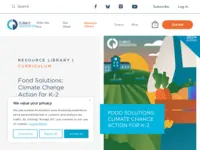Food Solutions: Climate Change Action for K-2
https://climategen.org/resources/48160/food-solutions-climate-change-action-for-k-2/
https://climategen.org/resources/48160/food-solutions-climate-change-action-for-k-2/
Alicia Fuller, Vanessa Go, Misty Goodman, Climate Generation
This resource engages students in 3 activities to help them understand the connections between food and climate change. Students will identify where food is accessed in their community and how it gets to their plates, explore local and seasonal foods as one of many food solutions to climate change, and engage in a class project to enhance climate-friendly food practices at their school.
This learning activity takes six 40 minute class periods.
Learn more about Teaching Climate Literacy and Energy Awareness»Grade Level
Online Readiness
Topics
Energy Literacy
This Activity builds on the following concepts of Energy Literacy.
Click a topic below for supporting information, teaching ideas, and sample activities.
Notes From Our Reviewers
The CLEAN collection is hand-picked and rigorously reviewed for scientific accuracy and classroom effectiveness.
Read what our review team had to say about this resource below or learn more about
how CLEAN reviews teaching materials
Teaching Tips | Science | Pedagogy |
Technical Details
Teaching Tips
- Excellent K-2 lesson plans for many different lessons using food as a way to introduce climate science.
- Talk to the cafeteria staff about a class interview, and come up with questions for the interview.
- Talking about air pollution may bring up stressful feelings for students. Consider a mindfulness/coping exercise here (see Appendix D) like the Internal Weather Check-in, Box Breathing, or the Butterfly Hug. To give students a stretch and movement break and relieve any tension from the lesson, wrap up with a mindfulness/coping activity. We recommend the Energy Exchange (Composting) activity in Appendix D.
- If your students were really excited by excursion to another part of the school, they may need a moment to reset. Share a mindfulness/coping strategy to help everyone settle back into their seats, such as the Shake it Off activity in Appendix D.
- When teaching about climate change, it is imperative to not bring a sense of doom to the students but be positive about solutions and ways they can help within their communities. Remember to be truthful and factual. Do not share more than the students seem ready for and always let them lead with questions. Remember to be solution-oriented.
- This resource is well-organized and easy to follow. It includes a table of contents, worksheets, references, and other supplemental material such as online and outdoor extensions. Teacher guidance and sequencing of lessons are appropriate.
About the Content
- This resource includes three lessons focused on where food comes from, how it is transported, and how to support sustainable food systems in schools.
- Students become familiar with what the word sustainable or earth-friendly means as it relates to food, what plants need to grow, the difference between weather and climate, and explore ways to reduce greenhouse gases, how processed foods, fertilizers, and pesticides affect the environment, and how humans can create positive changes.
- This lesson does an excellent job highlighting social justice discussions for each lesson plan as well as celebrating the cultural significance of the foods that we are celebrating in this lesson. Cultures including the Ojibwe in Minnesota are used as examples for students to build connections with different cultures around the world.
- Passed initial science review - expert science review pending.
About the Pedagogy
- Each lesson includes background information, learning outcomes, a list of relevant vocabulary, materials, and a teacher's guide discussion educator prep.
- Each lesson is divided into two parts; the first part contains three sections: engage, explore, and explain the second part is focused on elaborating. Extensions are also mentioned including books that make connections and how to take field trips to local places that continue the discussion further.
- The lessons contain both small and whole group activities, some of which are teacher-led and some are student independent.
- Different learning styles are addressed so that students can explore many different engaging activities, including any worksheets needed.
- The resource is for K-2 grade and was developed as a way to introduce climate change resources to younger students with something that is extremely relatable like food. Background information is included for each lesson, along with videos, maps, stories, interactive internet tools, action plans and questions to ask that allow for engaging lesson plans.
Technical Details/Ease of Use
- The lesson plan is easy to follow and is grade appropriate. Lessons are very clear, and any materials or worksheets are present. The guide provides many alternatives and modifications.
- The lesson does require a significant amount of time to complete (see notes on time).
- Educators need to make an account to access the lesson plan, but it is free to download.








